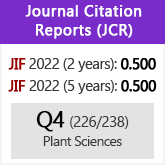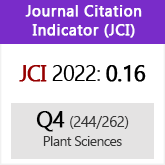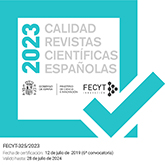Floral structure in the neotropical palm genus Chamaedorea (Arecoideae, Arecaceae)
DOI:
https://doi.org/10.3989/ajbm.2008.v65.i2.292Keywords:
Arecaceae, Chamaedoreeae, Chamaedorea, floral structure, anatomy, floral defenses, infrageneric classificationAbstract
Male and female floral structure has been studied in 28 species of Chamaedorea, the largest palm genus present in the Neotropics. The taxa investigated represent all subgenera according to the most recent taxonomic revision of the group. Morphological, histological and cytological features that are known to be of importance for interactions with visiting insects were studied and their putative role in protecting the flowering parts assessed. The taxonomic distribution of selected characters is in some cases congruent with relationships inferred by recently published molecular studies within the group.
Downloads
References
Asmussen, C.B., Dransfield, J., Deickmann, V., Barfod, A.S., Pintaud, J.C. & Baker, W.J. 2006. A new subfamily classification of the palm family (Arecaceae): evidence from plastid DNA phylogeny. Botanical Journal of the Linnean Society 151: 15-38. doi:10.1111/j.1095-8339.2006.00521.x
Bacon, C.D. & Bailey, C.D. 2006. Taxonomy and Conservation: A Case Study from Chamaedorea alternans. Annals of Botany 98: 755-763. doi:10.1093/aob/mcl158
Baker, W.J., Dransfield, J., Hedderson, T.A. 2000. Phylogeny, character evolution, and a new classification of the calamoid palms. Systematic Botany 25: 297-322. doi:10.2307/2666644
Barry, D. Jr. 1957. Comments on Chamaedorea palms. Principes 1: 91-93.
Bawa, K.S. 1980. Evolution of Dioecy in Flowering Plants. Annual Review of Ecology and Systematics 11: 15-39. doi:10.1146/annurev.es.11.110180.000311
Bawa, K.S., Perry, D.R. & Beach, J.H. 1985a. Reproductive Biology of Tropical Lowland Rain Forest Trees. I. Sexual Systems and Incompatibility Mechanisms. American Journal of Botany 72: 331-345. doi:10.2307/2443526
Bawa, K.S., Bullock, S.H., Perry, D.R., Coville, R.E. & Grayum, M.H. 1985b. Reproductive Biology of Tropical Lowland Rain Forest Trees. II. Pollination Systems. American Journal of Botany 72: 346-356. doi:10.2307/2443527
Berry, E.J. & Gorchov, D.L. 2004. Reproductive biology of the dioecious understory palm Chamaedorea radicalis in a Mexican cloud forest: pollination vector, flowering phenology and female fecundity. Journal of Tropical Ecology 20: 369-376. doi:10.1017/S0266467404001397
Croat, T.B. 1978. Flora of Barro Colorado Island. Stanford University Press, Stanford. 169 pp.
Cruden, R.W. 2000. Pollen grains: why so many? Plant Systematics and Evolution 222:143-165. doi:10.1007/BF00984100
Cuenca, A. & Asmussen-Lange, C. 2007. Phylogeny of the Palm Tribe Chamaedoreeae (Arecaceae) Based on Plastid DNA Sequences. Systematic Botany 32: 250-263. doi:10.1600/036364407781179644
Dransfield, J. & Uhl, N. 1998. Palmae. In Kubitzki K. Ed. Families and genera of vascular plants, flowering plants: monocotyledons, vol. 4, Springer, Berlin, pp. 306-389.
Dransfield, J., Uhl, N.W., Asmussen, C.B., Baker, W.J., Harley, M.M. & Lewis, C.E. 2005 A new phylogenetic classification of the palm family, Arecaceae. Kew Bulletin 60: 559-569.
Fisher, J. 1974. Axillary and dichotomous branching in the palm Chamaedorea. American Journal of Botany 61: 1046-1056. doi:10.2307/2441922
Fisher; J. & Moore, H.E. Jr. 1977. Multiple inflorescences in palms (Arecaceae): their development and significance. Botanische Jahrbücher für Systematik 98: 573-611.
Henderson, A. 1986. A review of Pollination Studies in the Palmae. The Botanical Review 52: 221-259. doi:10.1007/BF02860996
Henderson, A. 2002. Evolution and ecology of palms. The New York Botanical Garden Press. 259 pp.
Henderson, A. & Rodriguez, D. 1999. Raphides in palm anthers. Acta Botanica Venezuelica 22: 45-55.
Henderson A., Galeano, G. & Bernal, R. 1995. Field guide to the palms of the Americas. Princeton University Press, Princeton, New Jersey. pp. 352.
Hodel, D.R. 1992a. Chamaedorea Palms. The species and Their Cultivation. Allen Press, Lawrence. 338 pp.
Hodel, D.R. 1992b. Additions to Chamaedorea palms: new species from Mexico and Guatemala and miscellaneous notes. Principes 36: 188-202.
Hodel, D.R. 1995. Three new species of Chamaedorea from Panama. Principes 39 (1): 14-20.
Hodel, D.R. 1999. Problems interpreting variation in Chamaedorea (Palmae). Memoirs of the New York Botanical Garden 83: 185-189.
Hodel, D.R., Castillo Mont, J.J. & Zuniga, R. 1995. Two new species of Chamaedorea from Honduras. Principes 39: 183-189.
Listabarth, C. 1992. Insect-induced wind pollination of the palm Chamaedorea pinnatifrons and pollination in the related Wendlandiella sp. Biodiversity and Conservation 1: 39-50.
Moore, H.E. Jr. & Uhl, N.W. 1982. Major trends of evolution in palms. The Botanical Review 48: 1-69. doi:10.1007/BF02860535
Norup, M.V., Dransfield, J., Chase, M.W., Barfod, A.S., Fernando, E.S. & Baker, W.J. 2006. Homoplasious character combinations and generic delimitation: a case study from the Indo- Pacific arecoid palms (Arecaceae: Areceae). American Journal of Botany 93: 1065-1080. doi:10.3732/ajb.93.7.1065
Otero-Arnaiz, A. & Oyama, K. 2001. Reproductive phenology, seed-set and pollination in Chamaedorea alternans, and understorey dioecious palm in a rain forest in Mexico. Journal of Tropical Ecology 17: 745-754. doi:10.1017/S0266467401001559
Parthasarathy, M.V. & Klotz, L.H. 1976. Palm “wood”. I. Anatomical aspects. Wood Science and Technology 10: 215-229. doi:10.1007/BF00355742
Ramírez. F. 2002. Manual para el cultivo de XATE. Coordinadora Indígena Campesina Agroforestería Comunitaria Proyecto Sierra de Santa Marta, AC. 40 pp.
Richards, A.J. 1986. Plant Breeding Systems. George Allen & Unwin, London. pp. 285-330.
Thomas, M.T., Garwood, N.C., Baker, W.J., Henderson, S.A., Russell, S.J., Hodel, D.R. & Bateman, R.M. 2006. Molecular phylogeny of the palm genus Chamaedorea, based on the lowcopy nuclear genes PRK and RPB2. Molecular Phylogenetics and Evolution 38: 398-415. doi:10.1016/j.ympev.2005.08.019
Tomlinson, P.B. 1961. Anatomy of the Monocotyledons. II. Palmae. Clarendon Press, Oxford. 453 pp.
Tomlinson. P.B. 1990. The Structural Biology of Palms. Clarendon Press, Oxford. 477 pp.
Uhl, N.W. 1978. Floral anatomy of the five species of Hyophorbe (Palmae). Gentes Herbarum 11: 246-267
Uhl, N.W. & Dransfield, J. 1987. Genera Palmarum – A Classification of Palms based on work of Harold E. Moore, Jr. Allen Press, Lawrence. 610 pp.
Uhl, N.W. & Moore, H.E. 1971. The palm gynoecium. American Journal of Botany 58: 945-992. doi:10.2307/2441261
Uhl, N.W. & Moore, H.E. 1973. The protection of pollen and ovules in palms. Principes 17: 111-149. Prada, C., Rolleri, C.H. & Passarelli, L.M. 2008. Morfología, caracterización y distribución geográfica de Blechnum cordatum (Blechnaceae-Pteridophyta). Acta Botanica Malacitana (en prensa).
Ramos Giacosa, J.P, Giúdice, G.E., Morbelli, M.A. & Sota, E.R. de la. 2006. Estudio palinológico en Blechnum sect. Lomariocycas de Sudamérica austral. Revista del Museo Argentino de Ciencias Naturales, Resúmenes del XIII Simposio Argentino de Paleobotánica y Palinología: 114.
Rodríguez Ríos, R. 1995. Pteridophyta: 119-337. In: Marticorena, C. & Rodríguez, R.R. (eds.), Flora de Chile, I. Ediciones de la Universidad de Concepción.
Rolleri, C.H. & Prada, C. 2006a. Catálogo comentado de las especies mesoamericanas y sudamericanas de Blechnum L. (Blechnaceae- Pteridophyta). Anales del Jardín Botánico de Madrid 63(1): 67-106. doi:10.3989/ajbm.2006.v63.i1.36
Rolleri, C.H. & Prada, C. 2006b. Revisión de los grupos de especies del género Blechnum L. (Blechnaceae-Pteridophyta), el grupo B. penna-marina. Acta Botanica Malacitana 31(1): 7- 50.
Schelpe, E.A.C.L.E., 1952. A revision of the African species of Blechnum. Journal of the Linnean Society of London (Botany). III (355): 487- 510.
Schelpe, E.A.C.L.E. 1970. Blechnaceae (Pteridophyta). In: Exell, A.W. & Launert, E. (eds.), Flora Zambesiaca, pp. 235, Flora Zambesiaca Managing Committee, Kew.
Sota, E.R. de la. 1977. Pteridophyta. In: Cabrera A.L. (ed.), Flora de la Provincia de Jujuy, República Argentina: 1275. Colección Científica, Instituto Nacional de Tecnología Agropecuaria 13, Buenos Aires.
Sota, E.R. de la, Ponce, M.M., Morbelli, M.A. & Cassá de Pazos, L. 1998. Pteridophyta. In: Correa, M.N. (ed.), Flora patagónica: 282-369. Colección Científica, Instituto Nacional de Tecnología Agropecuaria 8, Buenos Aires.
Tryon, A.F. & B. Lugardon. 1990. Spores of the Pteridophytes: Surface, wall structure, and diversity based on electron microscope studies. Springer-Verlag, New York.
Tryon, R.M. & Stolze, R.G. 1993. Pteridophyta of Peru. Part. 5: Aspleniaceae-Polypodiaceae. Fieldiana, Botany, new series 32: 54-70.
Tryon, R.M. & Tryon, A.F. 1982. Ferns and allied plants with special reference to tropical America. Springer-Verlag, New York.
Downloads
Published
How to Cite
Issue
Section
License
Copyright (c) 2008 Consejo Superior de Investigaciones Científicas (CSIC)

This work is licensed under a Creative Commons Attribution 4.0 International License.
© CSIC. Manuscripts published in both the printed and online versions of this Journal are the property of Consejo Superior de Investigaciones Científicas, and quoting this source is a requirement for any partial or full reproduction.All contents of this electronic edition, except where otherwise noted, are distributed under a “Creative Commons Attribution 4.0 International” (CC BY 4.0) License. You may read here the basic information and the legal text of the license. The indication of the CC BY 4.0 License must be expressly stated in this way when necessary.
Self-archiving in repositories, personal webpages or similar, of any version other than the published by the Editor, is not allowed.

















